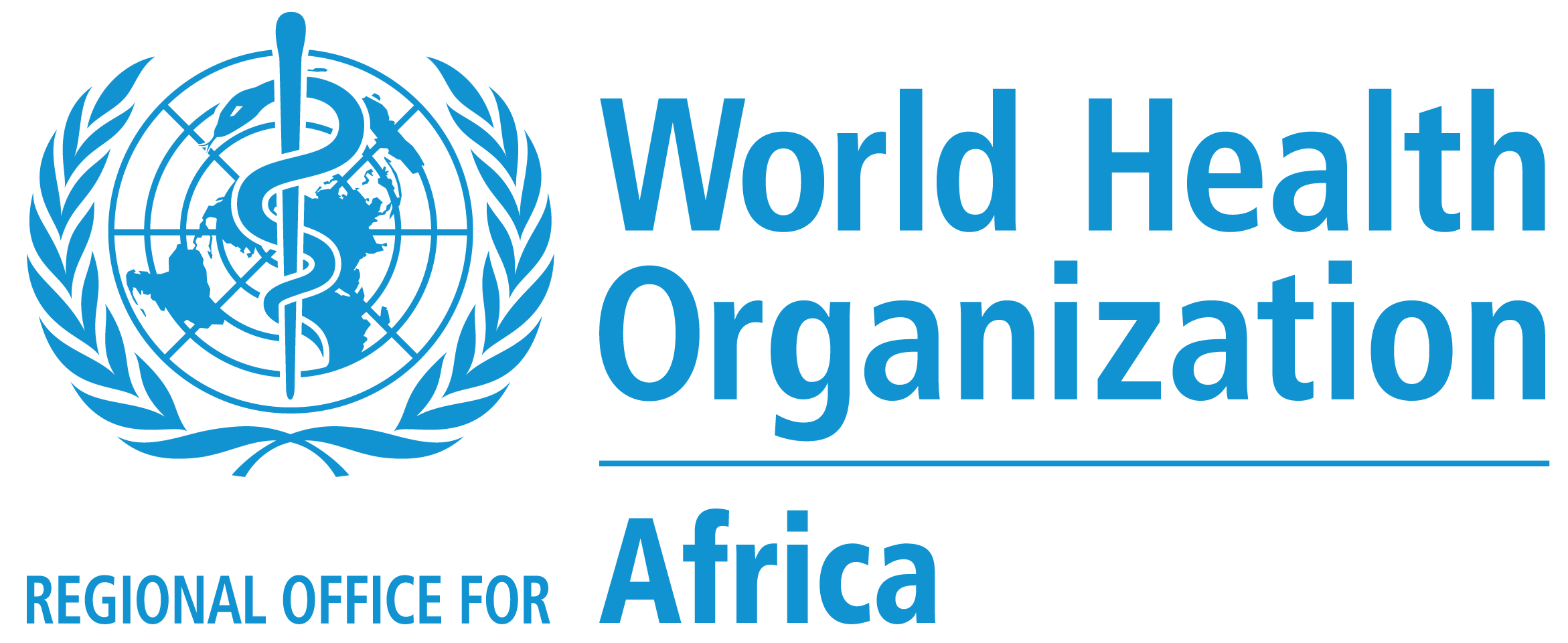Seven ways polio eradication benefited Africa
So far in 2020, the COVID-19 pandemic has claimed thousands of lives across Africa. The continent’s polio teams – the extensive network of healthcare workers, laboratory experts, data managers and community volunteers – were some of the first on the ground to support the response and help contain national outbreaks.
This is not the first time the polio programme has quickly pivoted to respond to a major or emerging public health event. Since the 1990s, the polio programme has brought the largest influx of public health expertise and funding across all countries in Africa. Polio teams and infrastructure have not only fought polio, they’ve contributed significantly to Africa’s public health and outbreak response.
Here are the most significant ways the polio response has changed public health across the continent:
A polio surveillance officer downloads data from vaccinators’ phones at the end
of the day’s polio vaccination campaign in Jere, Nigeria, 2020. ©️ Andrew Esiebo/WHO
1.
Demonstrating the importance of data for disease eradication
The polio programme has recognised the critical value of data in eradicating diseases and invested heavily in systems for data collection, management and usage. This includes gathering information on communities in need of vaccination, transport of laboratory samples, health worker movements and vaccine stocks. This data-driven approach is vital for other disease interventions, says Dr Ticha Muluh, Polio Surveillance Officer at the WHO Regional Office in Africa (WHO AFRO). “The polio programme used data to constantly redirect or innovate around activities. For any programme aiming for eradication of diseases, robust data should be key.”
A local government council meeting of polio experts and traditional leaders meets to analyse data collected from immunization campaign activities in Maideguri, Nigeria, 2020. ©️ Andrew Esiebo
A baby about to be immunized during a routine immunization session to her
nomadic community in the Lake Chad Basin, 2019. ©️ Christine McNab/UN Foundation
2.
Reaching every child with vaccines
Polio immunization activities have pushed the boundaries of what can be achieved through vaccination campaigns.
“Historically, routine vaccination was meant to achieve a certain level of population immunity to stop outbreaks but not enough for disease elimination,” says Dr Pascal Mkanda, Polio Eradication Coordinator for WHO AFRO. “But when countries saw how successful the polio programme was in using supplemental immunization activities for disease eradication, they started learning how to move beyond the reach of routine immunization systems towards the accelerated elimination of measles, yellow fever and others building on the experience of polio.”
In Nigeria and the Lake Chad region – regions that face particular challenges in routine immunization – the specialised approaches of the polio programme are used to reach remote island communities. In DRC, strategies to address a polio outbreak along the Congo River were adapted for routine immunization, while in Nigeria and South Sudan, negotiations with armed forces have enabled access to communities with routine immunization services, following the example of polio campaigns.
Today, almost 90% of WHO immunization staff in the African region are funded by the polio programme. Fragile states in particular are heavily dependent on polio infrastructure and funding for routine immunization and disease surveillance. With the expected decline in Africa’s polio funding, continued investment will be needed to protect this legacy to ensure universal access to immunization.
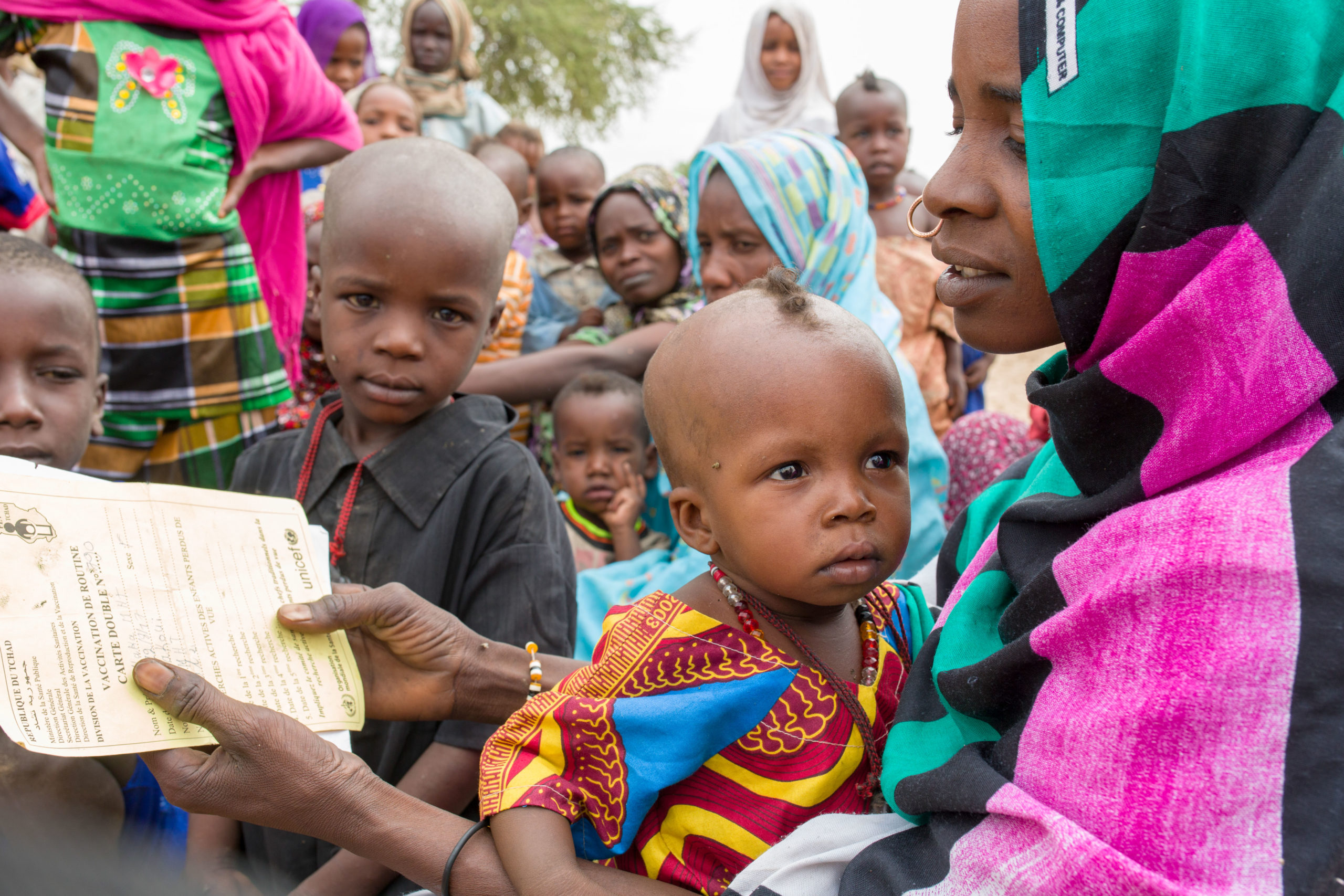
A mother in a nomadic community holds the immunization card for her young daughter, who will receive all routine vaccines, including polio, during an outreach campaign in the Lake Chad Basin, 2019 ©️ Christine McNab/UN Foundation
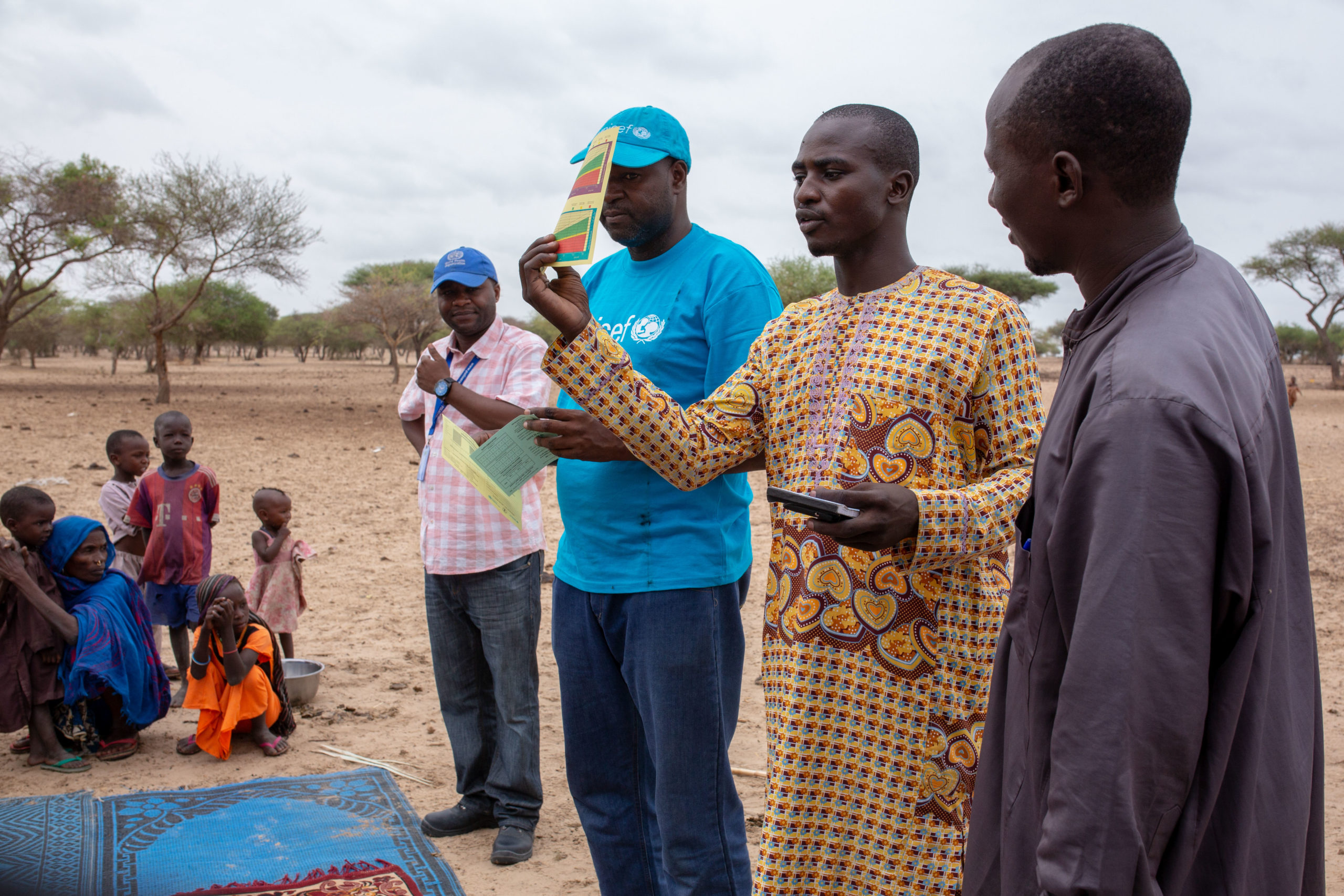
Health worker Awandi Epainette tells a nomadic community in Lake Chad about the benefits of vaccines in protecting children against a range of diseases – including polio, measles, meningitis A and hepatitis B – during an outreach campaign in the Lake Chad Basin, 2019. ©️ Christine McNab/UN Foundation
Peter Maritim, laboratory technologist, prepares polio cell cultures ready for extraction at the Kenya Medical
Research Institutes Expanded Programme on Immunization Laboratory, Nairobi, Kenya, 2018. ©️ WHO/L.Dore
3.
Strengthening disease surveillance and laboratory networks
The polio eradication effort has built a robust and sensitive epidemiological surveillance system in the African region, with a network of well-equipped laboratories and thousands of specially trained personnel – from virologists to local community health workers detecting suspected polio cases on the ground. Over the years, these systems have been used to detect other disease outbreaks and rapidly respond to contain their spread, particularly in areas with weaker health systems.
In the 1990s, as a result of weak public health surveillance across Africa, many countries in the region experienced multiple disease outbreaks, including cholera, measles and meningitis. The polio programme’s system for detecting and responding to cases of suspected polio was used to develop an Integrated Disease Surveillance and Response (IDSR) strategy that brought together surveillance, laboratory work and other data to coordinate responses to outbreaks across Africa.
The region-wide polio laboratory and field surveillance network has also served as a model for case-based surveillance, transportation of specimens and laboratory diagnoses. The region’s measles and rubella laboratory networks set up in the 2000s were based on the polio model, and are able to confirm diseases, sometimes within hours.
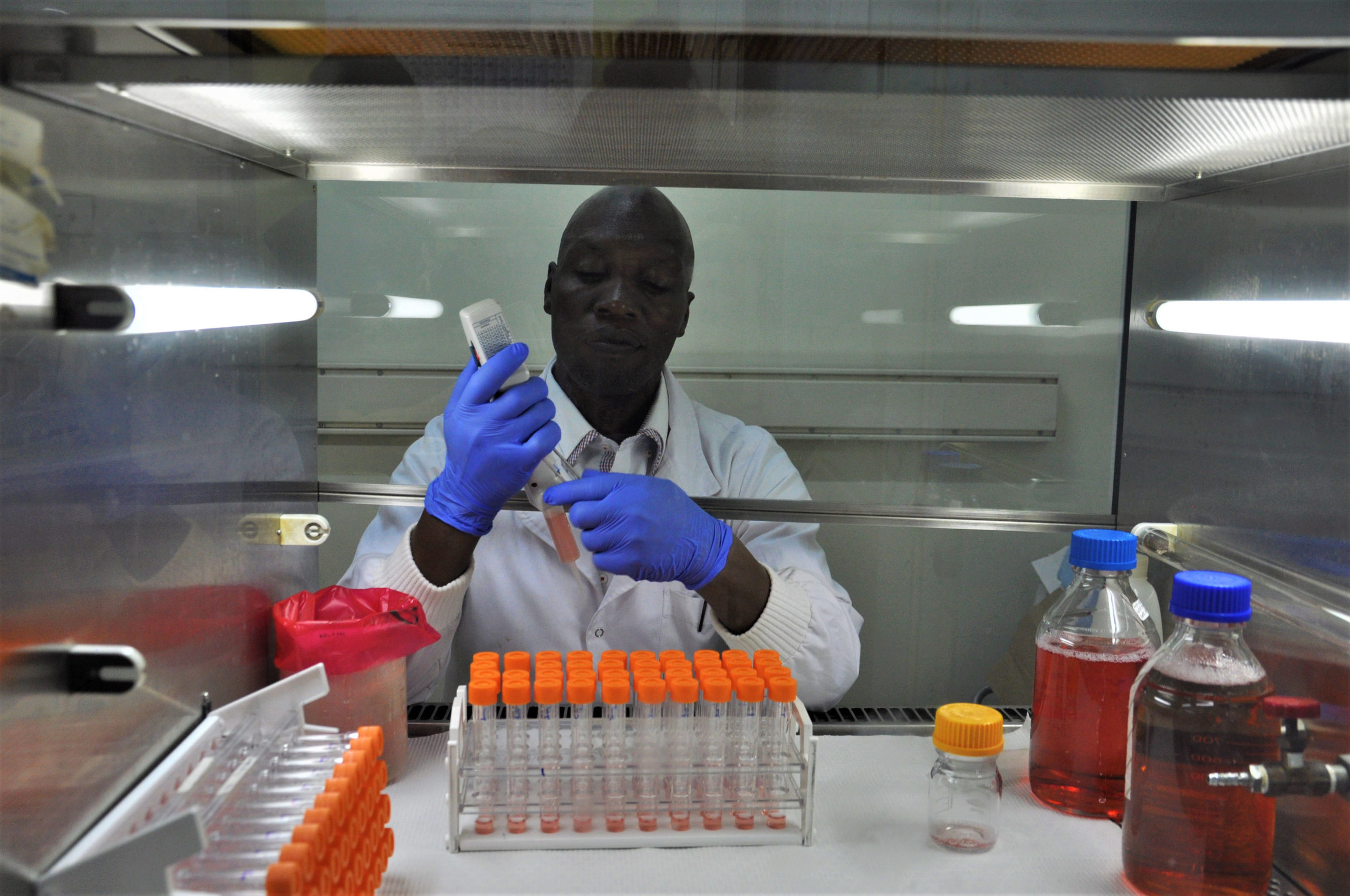
Peter Maritim, laboratory technologist, prepares polio cell cultures ready for extraction at the Kenya Medical Research Institutes Expanded Programme on Immunization Laboratory, Nairobi, Kenya, 2018. ©️ WHO/L.Dore
Volunteers are briefed on the national polio and vitamin A
campaign in Odienné village, Côte d’Ivoire, 2017. ©️ UNICEF
4.
Building Africa’s health workforce
The polio programme has helped to fill one of the biggest gaps in Africa’s healthcare systems: a shortage of skilled health workers. The continent is home to 11% of the world’s population and carries 24% of the global burden of disease. Yet, it has only 3% of the world’s healthcare workers.
Thousands of healthcare workers and community members have been trained as part of polio surveillance and immunization campaigns. These staff have been pivotal in strengthening routine vaccination and in delivering new vaccines and other treatments during polio campaigns. For example, polio staff in Angola have distributed vitamin A tablets as well as treated mosquito nets. In Chad, polio teams have taken a central role in rolling out yellow fever and meningitis vaccines.
Beyond vaccination and treatment handouts, polio personnel have used their particular expertise in preparedness and disease surveillance in other major outbreaks over the last 20 years, including recurrent outbreaks of plague in Madagascar and the recent Ebola outbreaks in Nigeria and in DRC.
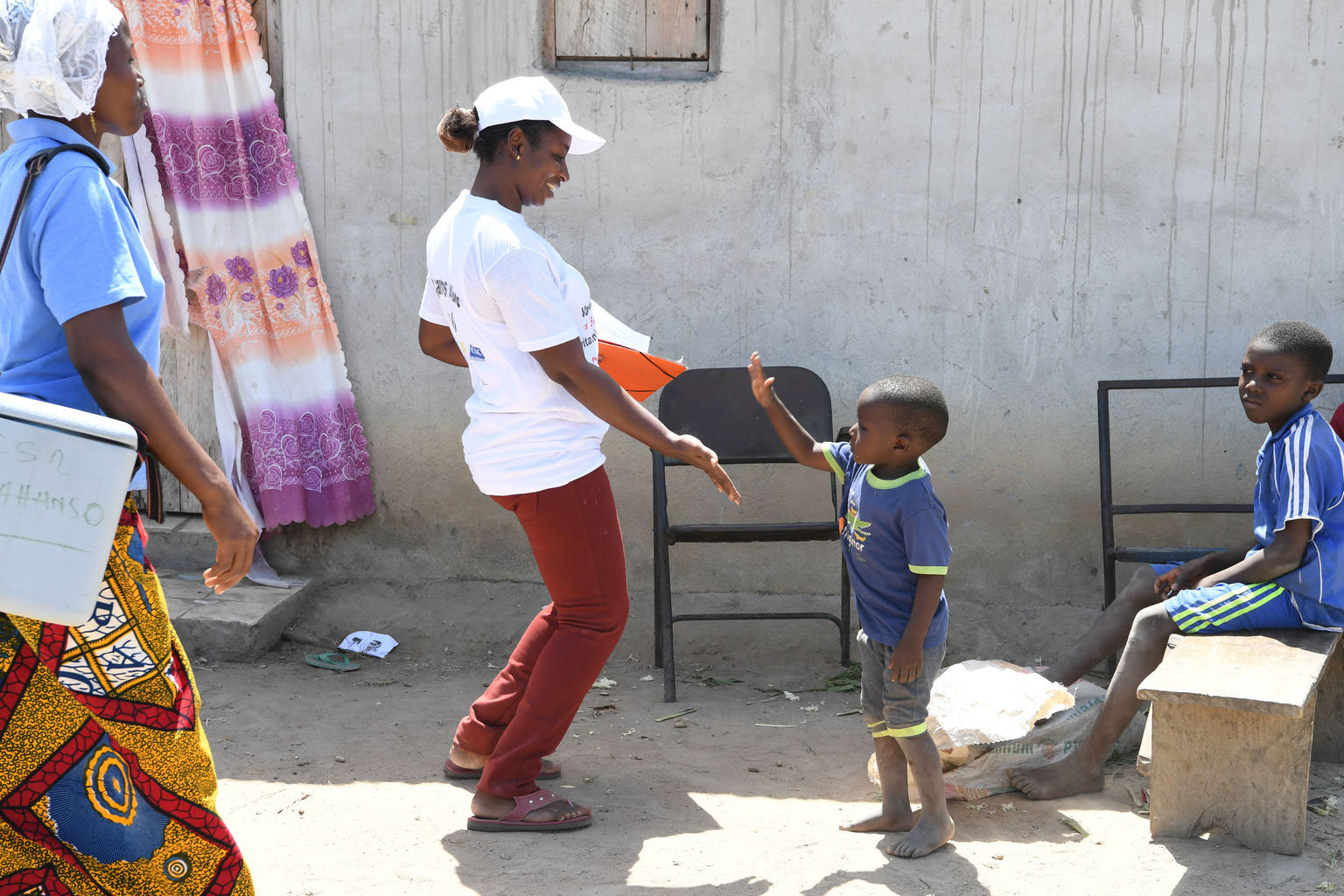
A polio volunteer plays with a child in a village in Odienné village, Côte d’Ivoire, while making sure that every child in the village has received their vaccinations as part of a national polio and vitamin A campaign, 2017. ©️ UNICEF
Residents of an internally displaced persons camp use water from a solar-powered
borehole system funded by Rotary in Maideguri, Nigeria, 2019. © Rotary International
5.
Reaching communities through social mobilisation, communication
The polio programme in Africa, as with elsewhere, has faced difficulties in gaining the trust of communities. In remote, marginalized or conflict-ridden communities, lack of awareness about health often comes with suspicion of government and NGO activities. In particular, the polio programme has faced vaccine refusal due to rumours and misinformation.
Early on, the polio programme largely relied on posters, radio and television advertising to announce vaccination days, which often failed to resonate in communities with low literacy or little access to media. The programme quickly developed better strategies and moved to targeted communication, known as ‘social mobilization.’ Thousands of volunteers, mostly women, were recruited from within communities to speak with caregivers about the importance of polio vaccination for their children. Their local knowledge helped increase communities’ acceptance of vaccines and helped polio programmes tailor their communication strategies.
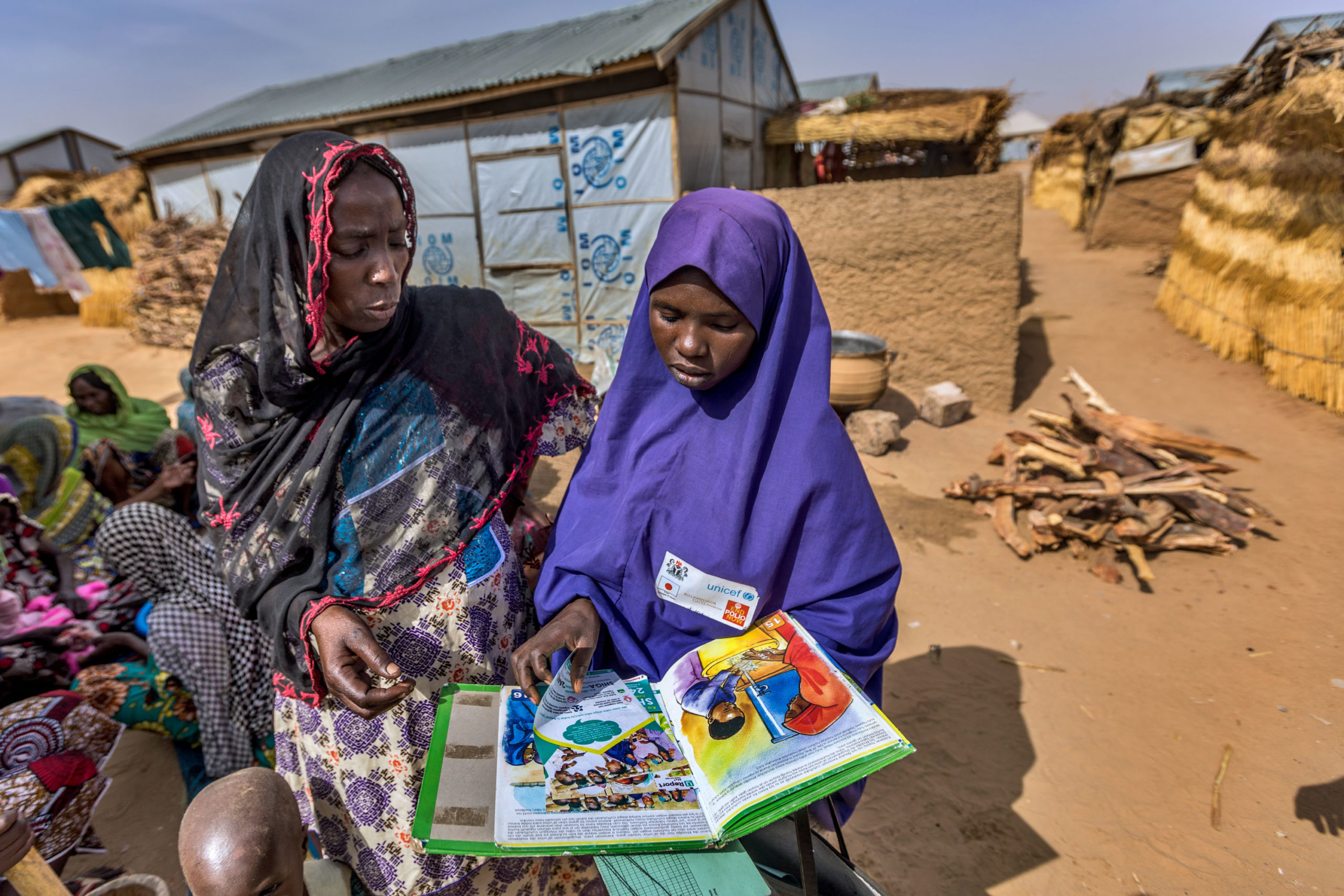
Volunteer community mobiliser Fatima Umar uses a pictorial flip book to communicate with Hadiza Zanna about maternal and child health, hygiene, vaccine-preventable diseases and the effects of polio in an internally displaced persons camp in Maideguri, Nigeria, 2019. © Rotary International
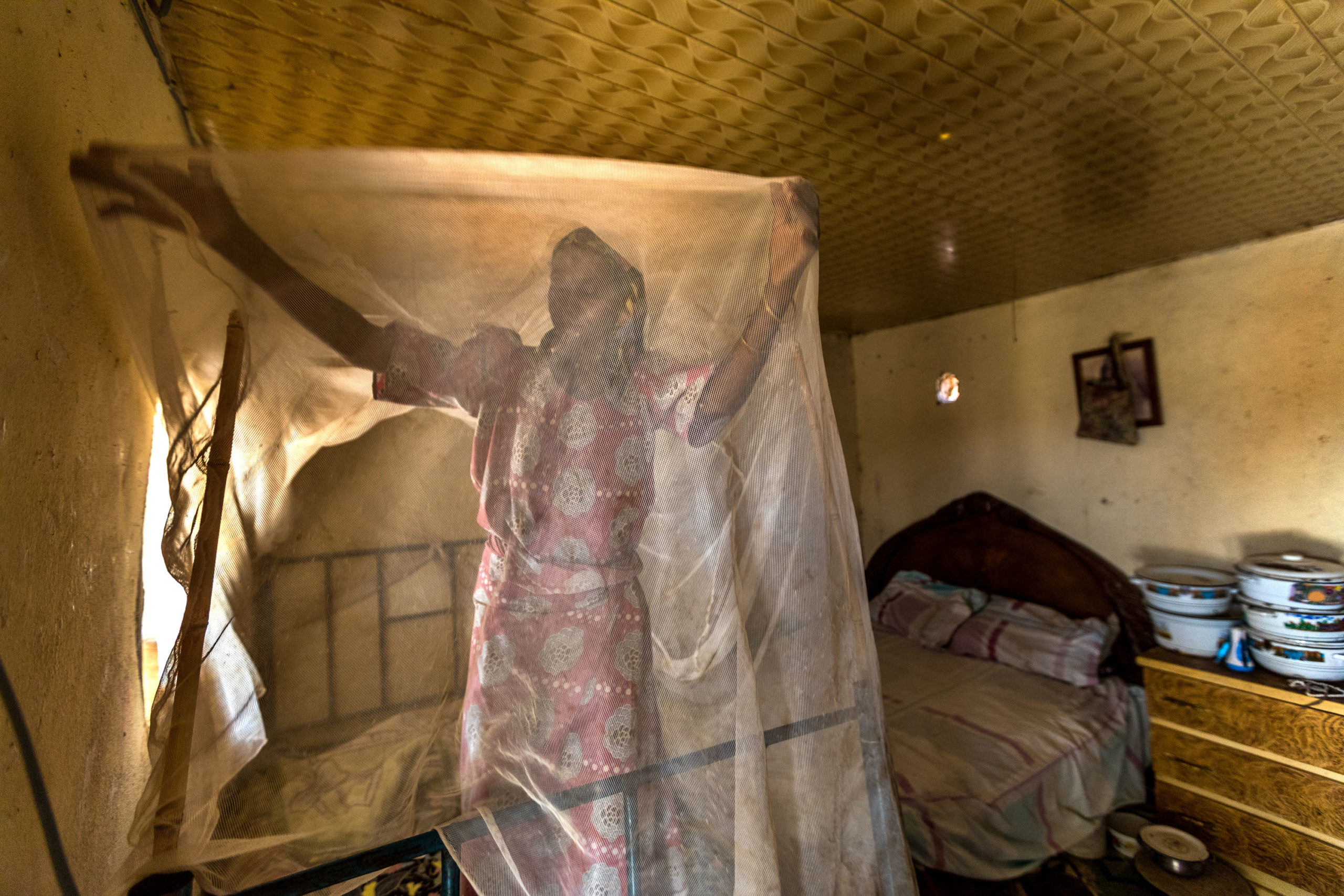
Hurera Idris installs a mosquito net in her room donated by Rotary in Kaduna, Nigeria, 2019. Credit: © Rotary International
These community mobilizers today play a critical role in disease prevention and response activities for other diseases, such as in cholera and measles outbreaks, and in addressing other health issues like malnutrition. In 2020, as part of the response to the COVID-19 pandemic, a network of more than 7,000 community health agents in Nigeria, most of them from the polio programme, have worked to educate families about the disease and prevention measures.
“Depending on the environment and what is seen as a need, we try to bridge the gap,” says Tunji Funsho, chair of Rotary’s Nigeria PolioPlus Committee. (Read more about Rotary’s PolioPlus program here).
An Emergency Operations Centre team debriefs after an assessment in Sokoto, Nigeria, 2017. ©️ WHO
6.
Improving outbreak response capacity
Africa has more disease outbreaks than other WHO regions. In 2018, WHO and partners supported emergency responses to more than 160 public health events in more than 40 out of the 47 countries in the region. With their unmatched experience and expertise, for the last 30 years polio teams have been the first on the ground to respond to non-polio health emergencies and infectious disease outbreaks – from frequent meningitis outbreaks across the Sahel to cholera in Zimbabwe.
The polio team’s huge network of community volunteers and health workers, as well as experts in communication, surveillance and logistics have had a vast impact on saving lives far beyond polio.
The creation of the Emergency Operations Centre (EOC) model—which serves as a central ‘command centre’ for rapid decision making—has inspired outbreak response and preparedness strategies for other diseases across the continent. First initiated in Nigeria in 2012 for polio, the EOC model was replicated in the country two years later to successfully contain an outbreak of Ebola.
More recently, the polio programme has supported the COVID-19 response, with more than 2,000 polio response experts from WHO, UNICEF, Rotary, as well as Stop Transmission of Polio (STOP) consultants from the United States Centres for Disease Control and Prevention working on COVID-19 in the African region. A quarter of WHO polio staff are dedicating more than 80% of their time towards COVID-19 efforts.
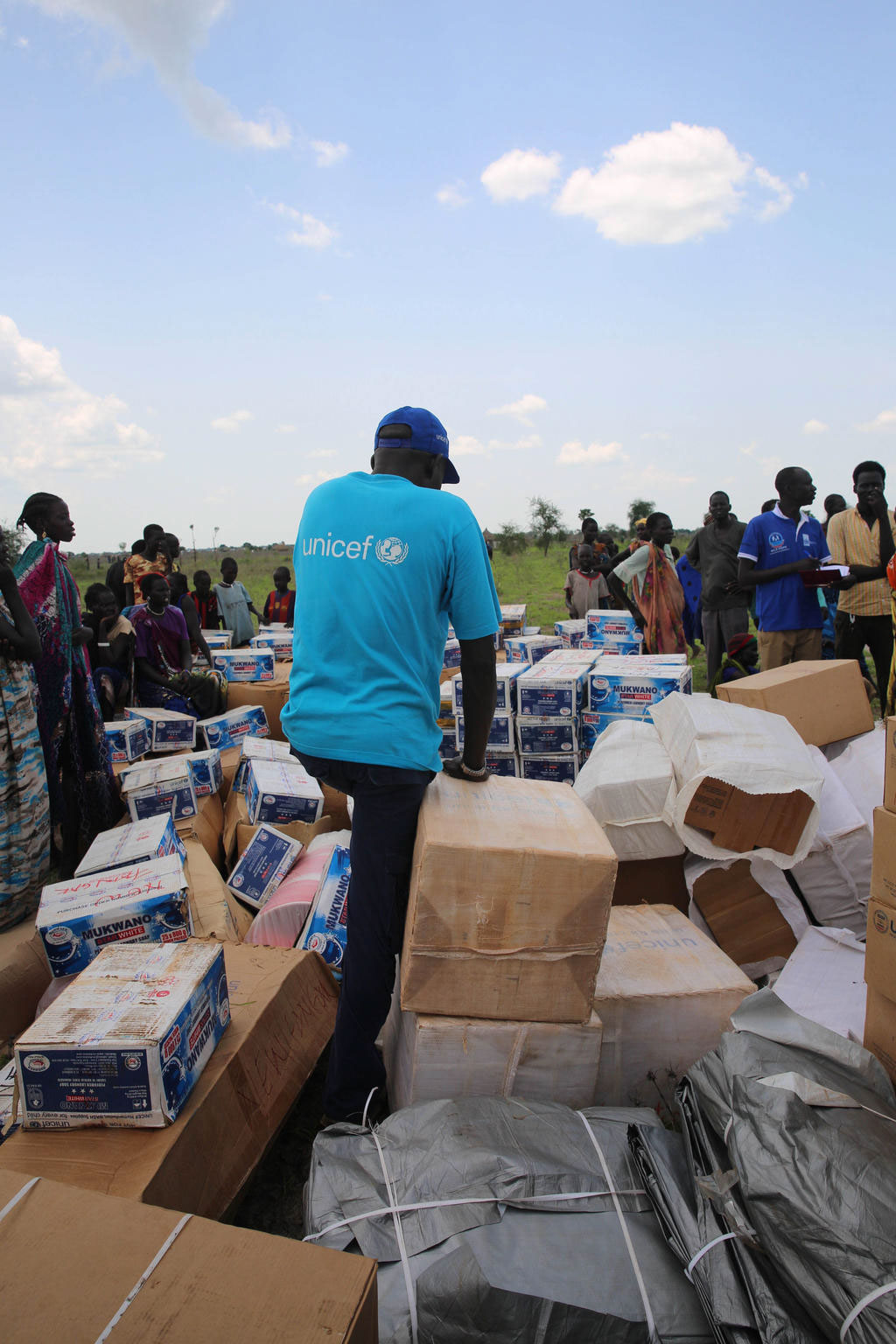
A UNICEF Rapid Response Mission delivers supplies, including vaccines and polio drops, nutrition supplements, child protection materials, education kits and WASH items, to New Fangkak, South Sudan. ©️ UNICEF
Kabir Rabiu, UNICEF officer in charge of theEmergency Operations Centre (EOC) in Kano,
Nigeria answers questions on the polio programme to visiting media, 2019. ©️ Andrew Esiebo/WHO
7.
Implementing accountability frameworks
The continual efforts to improve the polio programme’s performance brought a strong focus on accountability and monitoring activities to maximize results from resources.
In 2013, a GPEI report estimated that $250 million would be required per year between 2013 and 2018 to successfully eradicate wild poliovirus from Nigeria. The unprecedented investment into the programme by donors such as the Bill & Melinda Gates Foundation and Rotary required the programme to clearly demonstrate results and show accountability and transparency using a systematic evaluation.
Since then, accountability frameworks based on this model have been used to ensure the timely allocation of resources and enhance performance. These frameworks have not only transformed polio programmes, but have been institutionalized across Africa’s health systems.
A legacy of eradication
The polio program’s impact on public health in Africa is unmatched; it reaches far beyond polio, encompassing all areas of healthcare, touching everyone, from newborn babies in remote villages to political leadership. The program has, as such, transformed perceptions of what the future holds for health in Africa.
“Polio has brought back the belief that disease eradication is possible,” says Dr Francis Kasolo, Director in the Regional Director’s Office at WHO AFRO. “It’s a question of now identifying the priority diseases that communities think we should be getting rid of – what should we be investing in?”
With the eradication of wild polio in the African region declared in August 2020, the polio program has begun transitioning its staff and assets to countries. New commitments and resources will be needed to build on this legacy and ensure that polio’s contributions to Africa’s health systems are not lost, but instead used to strengthen public health for generations to come.
